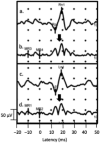How to interpret latencies of cervical and ocular vestibular-evoked myogenic potentials: Our experience in fifty-three participants
- PMID: 24962335
- PMCID: PMC4714861
- DOI: 10.1111/coa.12277
How to interpret latencies of cervical and ocular vestibular-evoked myogenic potentials: Our experience in fifty-three participants
Figures



Similar articles
-
An acoustically evoked short latency negative response in profound hearing loss infants.Auris Nasus Larynx. 2008 Sep;35(3):328-32. doi: 10.1016/j.anl.2007.07.014. Epub 2007 Oct 29. Auris Nasus Larynx. 2008. PMID: 18029126
-
Response to "oVEMP to air-conducted tones reflects functions of different vestibular populations from cVEMP?".Eur Arch Otorhinolaryngol. 2011 Jan;268(1):151-2; author reply 153. doi: 10.1007/s00405-010-1444-3. Epub 2010 Dec 2. Eur Arch Otorhinolaryngol. 2011. PMID: 21125289 No abstract available.
-
[Tips & tricks: dynamic frequency analysis of otolith function using vestibular evoked myogenic potentials (VEMP)].Laryngorhinootologie. 2015 Mar;94(3):153-5. doi: 10.1055/s-0035-1546460. Epub 2015 Mar 11. Laryngorhinootologie. 2015. PMID: 25760258 German. No abstract available.
-
Clinical significance of cervical and ocular vestibular evoked myogenic potentials in benign paroxysmal positional vertigo: a meta-analysis.Eur Arch Otorhinolaryngol. 2019 Dec;276(12):3257-3265. doi: 10.1007/s00405-019-05674-4. Epub 2019 Oct 11. Eur Arch Otorhinolaryngol. 2019. PMID: 31605189 Review.
-
A review of the scientific basis and practical application of a new test of utricular function--ocular vestibular-evoked myogenic potentials to bone-conducted vibration.Acta Otorhinolaryngol Ital. 2009 Aug;29(4):179-86. Acta Otorhinolaryngol Ital. 2009. PMID: 20161874 Free PMC article. Review.
Cited by
-
Vestibular Impairment in Dementia.Otol Neurotol. 2016 Sep;37(8):1137-42. doi: 10.1097/MAO.0000000000001157. Otol Neurotol. 2016. PMID: 27466890 Free PMC article.
-
Increased Prevalence of Vestibular Loss in Mild Cognitive Impairment and Alzheimer's Disease.Curr Alzheimer Res. 2019;16(12):1143-1150. doi: 10.2174/1567205016666190816114838. Curr Alzheimer Res. 2019. PMID: 31418661 Free PMC article.
-
Age-related changes to vestibular heave and pitch perception and associations with postural control.Sci Rep. 2022 Apr 19;12(1):6426. doi: 10.1038/s41598-022-09807-4. Sci Rep. 2022. PMID: 35440744 Free PMC article.
-
Vestibular Evoked Myogenic Potential on Ocular, Cervical, and Soleus Muscles to Assess the Extent of Neurological Impairment in HTLV-1 Infection.Front Neurol. 2020 May 21;11:433. doi: 10.3389/fneur.2020.00433. eCollection 2020. Front Neurol. 2020. PMID: 32508741 Free PMC article.
-
Association Between Saccule and Semicircular Canal Impairments and Cognitive Performance Among Vestibular Patients.Ear Hear. 2020 May/Jun;41(3):686-692. doi: 10.1097/AUD.0000000000000795. Ear Hear. 2020. PMID: 31567562 Free PMC article.
References
-
- Singh NK, Kashyap RS, Supreetha L, et al. Characterization of age-related changes in sacculocolic response parameters assessed by cervical vestibular evoked myogenic potentials. Eur Arch Otorhinolaryngol. 2013;271:1869–1877. - PubMed
-
- Funahashi K, Imae S, Kuwata T, et al. Postauricular response in motor paresis with intracranial lesions. Neurol Med Chir (Tokyo) 1992;32:566–571. - PubMed
-
- Welgampola MS, Colebatch JG. Characteristics and clinical applications of vestibular-evoked myogenic potentials. Neurology. 2005;64:1682–1688. - PubMed
Publication types
MeSH terms
Grants and funding
LinkOut - more resources
Full Text Sources
Other Literature Sources

